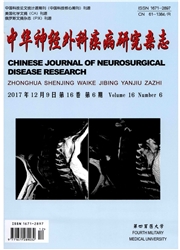

 中文摘要:
中文摘要:
目的探讨组蛋白修饰与人脑星形细胞瘤发生及病理分级的关系。方法选取西京医院神经外科2006年至2008年经病理证实的星形细胞瘤患者肿瘤组织标本67例和正常脑组织标本10例,通过免疫组化方法,检测组蛋白3个位点(H3K4diMe、H4K12Ac、H3K18Ac)的修饰水平。结果在正常脑组织中组蛋白3个位点均无修饰;在星形细胞瘤中均有修饰,有2个位点(H3K4diMe、H4K12Ac)的修饰水平随星形细胞瘤病理级别的增高而升高,且呈现明显差异(P〈0.05),但H3K18Ac的修饰水平并末随肿瘤病理级别的增高发生显著变化。结论组蛋白修饰与人脑星形细胞瘤的发生有关,且修饰水平的变化与病理级别相关。
 英文摘要:
英文摘要:
Objective To investigate the relationship between epigenetic changes involving multiple modifications of histone and pathological grades of astrocytomas. Methods Immunohistochemistry was performed to evaluate the level of histone 3 lysine 4 dimethylation (H3K4diMe), histone 4 lysine 12 ( IWK12Ac ) and histone 3 lysine 18 (H3K18Ac) in resected tumor samples of 67 astrocytoma patients and normal brain tissues of 10 non-cancer patients. Results H3K4diMe, H4KI2Ac and H3KI8Ac were all detected at high frequencies in astrecytoma samples, while none of the control normal brain tissue showed the histone modification abovementioned. The expressions of H3K4diMe and IMK12Ac were positively correlated with the increase of WHO grades (P 〈0. 05), while H3K18Ac staining was not significantly correlated with WHO grades. Conclusion Multiple modifications of histone may affect several steps in tumor cell biology, and may have a prognostic value for astrocytomas since specific modifications are correlated with WHO grades.
 同期刊论文项目
同期刊论文项目
 同项目期刊论文
同项目期刊论文
 期刊信息
期刊信息
